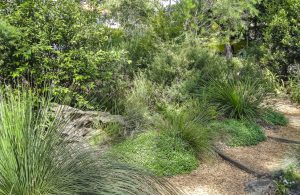Originally published in the Hunter Valley group newsletter ‘Gumleaves’
The weather forecasts now have us coming out of the wet La Nina conditions over the last few years and heading into the warmer & drier El Nino weather pattern. This will have resting effects on our gardens and can lead to plant loss and damage. With a little thought and preparation it is possible to minimise the problems that can come from this change in weather conditions.
Pruning – removal of above ground growth, in addition to shaping the plants, can significantly reduce the water needs of the plants. Pruning should be done back to branch junctions to avoid encouraging further branching and soft new growth.

Mulching – a layer of coarse mulch (only needs to be 3-4cm thick) can also help to reduce water loss, and by shading the soil it also keeps soil temperatures down and protects the surface roots. Further benefits like keeping weeds down, makes this a “no brainer”. Any pruning done earlier can be chipped & converted into mulch to make for a double water saving benefit.
Plant Groupings – where possible plants with similar water requirements should be grouped together, as well as being better for the plants (i.e. not mixing dry zone plants with rainforest plants), it can help to save water by ensuring that each grouping gets only the water that is needed.
Watering Patterns – rather than frequent shallow watering, you should aim to reduce the frequency of watering (particularly with established plants), but make each watering longer and deeper. This will encourage deeper root growth as the plants seek water from further down.
Improving the Soil – the soil itself can be improved so that it both allows for greater water penetration and water holding capacity. If you have a clay based soil, the addition of Gypsum can help to improve the structure of the soil and this will allow greater water penetration. The other thing that improves all soil types (clay & sandy) is the addition of organic matter. This can both help with the soil structure and the water holding capacity of the soil.
Soil Wetting Agents – these help to break down the waxy hydrophobic coatings that can form around the soil particles. As such they help with water holding and ensure a more even distribution of water in the soil profile.

Smart Watering Systems – a good watering system (drippers & sprinklers) can help save time (and often water) when trying to keep a garden going when it is dry. Any existing systems should also be given a check out to ensure proper coverage and that there are no leaks and it is operating as expected. Some of the new smart timers include flow meters to measure usage and apps that can shut off the watering if rain is predicted. If on clay or loamy soils, then droppers are best in the garden, for sand you may need sprinklers – check for the high efficiency ones with adjustable coverage arcs.
Shade – areas of the garden that are in the shade for the hotter parts of the day will not dry out as much as areas that are more exposed. This can be taken advantage of when planting to keep the less drought tolerant plants in these areas.
When to Plant – Generally the best time to plant in our region is in Autumn – Winter. This allows the plants time to establish before the hot dry summer hits, and the cooler temperatures and more reliable autumn rains make watering for establishment easier.
